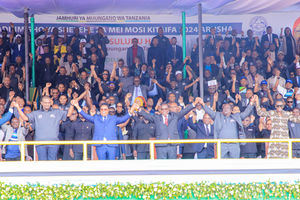Consumers cry hoarse as govt insists about being liquid

Stacks of Tanzanian Shilling notes. PHOTO|FILE
What you need to know:
This reverse trend is being experienced at a time when the government is said to be liquid – while the consumer market is facing a cash drought.
Dar es Salaam. After recording an upward trend for the last four consecutive months, Tanzania’s extended broad money supply (M3) headed in the opposite direction in July this year.
This reverse trend is being experienced at a time when the government is said to be liquid – while the consumer market is facing a cash drought. This almost automatically impacts consumption trends.
Extended broad money – codenamed ‘M3’ – consists of currency in circulation outside banks; shilling demand-deposits among local Tanzanians- time-and-savings deposits, and foreign currency deposits by Tanzanian residents.
The monthly economic review for August this year published in Dar es Salaam last week by the Bank of Tanzania (BoT) states that the annual growth rate during July this year was 5.8 per cent, down from the six per cent which in June.
Whichever way you look at it, both rates are lower than the annual growth of 12 per cent that was recorded in June last year.
This relatively lowly pace of economic growth might be within the targets of the Monetary Policy Statement (MPS) for June expectations, which had it that the central Bank of Tanzania was targeting an annual M3 growth of not more than 12 per cent.
However, this has created liquidity stresses among Tanzanian consumers, as credit to the private sector remains the main source in stimulating consumptions among Tanzanians – which helps producers to sell more, and the government to generate tax revenues.
Analysts say the trend might derail the country’s economic growth progress, and may affect improvement of economic efficiency and stability in the coming years.
The BoT review says that the drop of money supply during July was a result of the low increase in credit to the private sector, compounded by the decline in net credit to government from the nation’s banking system.
The shrink of net credit to the government from the banking system was caused by strong deposits at the Bank of Tanzania by the government, following improvement in domestic revenue collections.
Net credit to the government from the banking system decreased by 23 per cent during the year that ended in July this year, compared to increase of 12.4 per cent recorded during the year ending in July 2016.
The review also shows that the government borrowed about Sh3.5 trillion from the banking system in July this year – lower than the Sh5 trillion it borrowed in May. In July last year, the government borrowed Sh4.5 trillion from the same source.
According to the central bank’s review, the growth of credit to government from the banking system has been in a negative trend since October last year – and started recording a negative growth since November that year.
Credit to private sector from the banking system also faced massive cuts, including the key economic sectors of agriculture, hotels and restaurants, transport and communication, as well as personal loans. All thes account for a large share of credits.
Furthermore, the review found that the annual growth of credit to the private sector shrunk to one per cent in July this year, down from 18 per cent in July last year – and more than 24 per cent in January last year.
The decline in credit to the private sector over the last six months reflects the cautious stance taken by most of the banks in extending credit – especially following weakening of the banks’ asset quality, coupled with slower growth of deposit liabilities and portfolio diversification in favour of low-risk assets, such as government securities.
Lending by the banks to the private sector was about Sh250 billion in July this year which was substantially lower than the Sh500 billion recorded in June. That amount was also lower than the more than Sh2 trillion borrowed by the private sector in July last year.
The slowdown in credit growth was also recorded in transport and communications, as well as in agriculture and personal loans. In fact, transport and communication recorded negative credit growth.
On the other hand, building and construction, as well as hotels and restaurants, recorded strong credit growth.
“The impact of the slowdown in the growth of domestic credit on money supply was toned down by an increase in Net Foreign Assets (NFA) of the banking system – ordinary banks and the central Bank of Tanzania – which rose by 30.4 per cent in the year to July 2017. (This is) compared to the decline of 9 per cent in the corresponding period in 2016,” the BoT review concludes.
The growth of NFA of the banking system was driven by an increase in holdings of foreign exchange by the Bank of Tanzania, which emanated from the disbursement of external non-concessional loans in favour of the government, as well as the purchase of foreign exchange from the inter-bank foreign exchange market, says the BoT.




